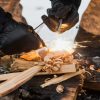When SHTF, you’re going to need to know how to make a fire. It’s one of the most essential skills for surviving a disaster alongside finding water and storing food, and it’s unfortunately one that very few are aware of these days, thanks to automated cookers, lighters, portable barbecues, and other technology. The very first
When SHTF, you’re going to need to know how to make a fire. It’s one of the most essential skills for surviving a disaster alongside finding water and storing food, and it’s unfortunately one that very few are aware of these days, thanks to automated cookers, lighters, portable barbecues, and other technology.
The very first step of this surprisingly easy process is deciding which type of tree gives the best firewood to use for your survival fire. So here we’ll provide a quick look at what your best firewood options are inthe UK, where they can be found, and how to distinguish them from others.
Around 100 different types of tree grow in the UK, so you have plenty of choice, but not all of them burn the same and have a range of different qualities.
Here is a great guide of all the main British trees, as to know which tree is which beforehand is a must. Take a look at the guide and make it your homework to memorise them, take a walk in the local park and see how many you can identify by their shape, the leaves or the bark.
It’s an excellent opportunity for younger preppers in the family too to learn about the trees in their native homeland as children in times gone by did.
The best way to remember all of the woods you can use for a fire comes thanks to a poem by Lady Celia Congreve, which was published in a 1930s paper. If you can memorise this poem or work it into a song to teach your children too, you’ll have no problem finding the right firewood.
As the poem states, some logs need to be stored for a year before they can be used, so bear that in mind when choosing the best firewood sources. Ash is the best wood by far, however in a survival situation, if it’s brown and dry, throw it on and it’s sure to burn and keep you warm.

1. Ash
As you can tell from the poem above, this is by far one of the UK’s most common trees and the best firewood. If you look out the window and can see a tree, chances are that it’s one of these.
Ash is one of the most highly regarded trees for using as firewood because it has a naturally low water content level and can be burned while green – meaning you don’t have to wait as long as others for it to be dry enough for use. What’s more, it can be chopped with a small axe.
Its compound leaves generally have five to nine leaflets, which grow directly opposite from one-another. You can also use its diamond-shaped bark ridges as proof of ID.
2. Oak
There are few things as iconic to the UK as the wise English oak – it’s basically a floral version of the great British bulldog. And as it’s iconic, it’s also very common, and can often be found towering over other trees in woods, greenlands, and forests throughout the nation.
Look for short stalks located towards the bottom of each leaf. You’ll also recognise the acorns, which feature a very long, disproportionate stem, called a peduncle.
Oak is one of the most favoured trees to use for fires, as it burns very slowly and ensures a long duration, even with smaller logs, acting as an excellent foundation for your inferno. This is ideal if you’re looking to keep a small fire burning overnight to keep you warm.
3. Hawthorn
This is one of Britain’s favourite trees, and changes its appearance rapidly throughout the year – and it’s very common thankfully.
Key areas worth noting include cracked, thorny bark and long, sharp thorns across its branches. It also features beautiful white blooms that change in appearance throughout the year, depending on the season you’re on the search firewood.
Survival experts are very fond of hawthorn as it burns very well, is easy to chop with an axe, and boasts a good heat output and little smoke – proving, once again, to be a good fire to leave as embers overnight while you sleep.
4. Birch
This is one of the best trees to utilise for those who aren’t 100% sure what they’re doing. It burns easily, and can be used unseasoned, unlike many others on this list. You can also tap them for fresh water during certian times of the year.
As a pioneer species, they’re quick to grow – meaning even one birch can act like a gold mine for the best firewood to have around your camp.
The one downfall is that it burns easily, meaning only short-lived fires can be made from it, unless combined with slower-burning counterparts like oak. Birch trees feature an uncomplicated leaf that small serrations on the outside.
As there two types – silver and downy – you will need to distinguish between the two, but there’s not too much to look for. The downy just tends to have more rounded leaves than its counterpart. Check for bright bark that darkens within its (short) lifespan, and you’ll also notice a number of dark lines going horizontally across the bark.
5. Elm
Elm is a great wood to use, but it is quite high maintenance. It must be seasoned for a very long time before it can be utilised, and by this time, you’re much better off finding an alternative.
However, if some is readily available, then you’re in for a treat. Elm burns very slowly, so needs to be combined with a faster-burning wood for stability, but once you’re up and running, you’re good to go. This is an excellent wood to use for longevity – once again, a good overnight wood to use.
Elms have asymmetrical leaves with short stalks, and in bloom, they produce winged fruit. There’s also incredibly tall, ranging into the 30 metres, and are located throughout England and Wales.
6. Hazel
This is an excellent firewood to use and it causes minimal spitting, meaning it’s as safe as an amateur creating a towering inferno can be. Hazel is one of the best trees for coppicing, providing a rapidly regenerating source of heat.
Simply trim the ends of the branches and wait for it to grow back again. To distinguish hazels from other trees, check the leaves. They start to grow in May, and you’ll notice daggered, asymmetrical edges that often come with red tinges. They also feature hair on the surface, with distinct tips at the end.
The bark is yellow and comes with smooth pores. To find hazels, check damper areas of the woodland, such as near rivers, streams or flood plains.It is also quite easy to saw whether you’re using a hand saw or folding saw.
Summary
Evidently, there’s a huge number of trees native to the UK that you can use for firewood, but those six above should be your go-to choices if you have options.
Use the information to determine which you’re dealing with, as you’ll often need to distinguish between them due to the varying nature of the burning qualities.
Try to combine a slow burner with faster release woods, or those that require extensive seasoning with those that require very little. From cooking to warmth, there’s an endless list of reasons why you should know what woods to use for fires.





















